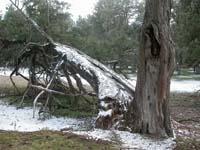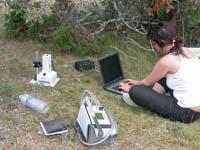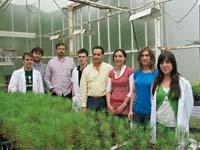Measuring the stress of forests

In most cases, however, the very nature itself shakes the plants. The amount of light, source of energy in normal conditions, is transformed into excess in winter (due to the cold) and in summer (due to high temperatures and droughts), since the metabolism of the plants cannot absorb properly. This process is called photooxidation stress.
Some plants are unable to withstand this stress. By not being able to properly disperse excess energy, they produce a chain reaction that gradually deteriorates until his death. Other species, on the other hand, initiate an air conditioning process and activate chemical self-protection compounds, that is, they adapt to the new situation. These chemical compounds are of interest to a group of researchers from the Department of Plant Biology and Ecology of the Faculty of Science and Technology of the UPV/EHU.
The EKOFISKO group, led by Dr. Txema Becerril, investigates the plant protection mechanisms to detect them before the damage occurs. They measure photo-protective substances that produce plants and analyze their behavior using as biosensors of photooxidation stress.
Among the plants, trees and the rest of forest species are analyzed. In fact, as long cycle species, it must ensure its proper adaptation to the medium before starting the reforestation work. They investigate the native species of the Autonomous Community of the Basque Country, especially those of the South, which are located on the border between the Atlantic climate and the Mediterranean, which is why they would suffer the first damage to climate change. They study species with deciduous and persistent leaves that adapt to cold temperatures without losing the leaf.
On the road to Ezpela

To measure the biomarkers of photooxidation stress, they simulate the winter and summer conditions in the greenhouse of the Faculty of Science and Technology and in the farming chambers, that is, they artificially affect the plants the conditions of these seasons. Thus, they only analyze the consequences of each stress agent, apart from the rest of variables that can be found in nature.
UPV researchers have shown that the secret of adaptive species is the accumulation of antioxidants, such as vitamin E and special carotenoids (carotene and xanthophylls), substances that alter the color of plants. When they receive too much light, the plants start the VAZ cycle: the balance between the three xanthophylls corresponding to these three initials changes so that this excessive energy does not damage the plants. In addition to investigating the VAZ cycle, the team of Txema Becerril (epoxy lutein cycle) has found a cycle that so far has not been known. This cycle is present in many forest species, such as beech, laurel, and still oak, and is now investigating its protective function.

Buletina
Bidali zure helbide elektronikoa eta jaso asteroko buletina zure sarrera-ontzian











